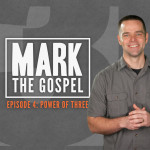Repeating a pattern three times is a common storytelling technique and Mark uses it to great effect. Through it, he ties his book together and highlights his message that Jesus is the Son of God.
Have you noticed the parallels between Jesus’ baptism and transfiguration?
If you haven’t read Mark, take the next hour and read it all in one sitting, just like you’d watch a movie. Finding these parallels and patterns is just part of the fun of a good story’s game.
Let’s start with the transfiguration in chapter 9. Jesus goes up on a mountain with some of his disciples and there, his clothing begins to glow. Suddenly, Moses and Elijah appear! And the disciples are utterly terrified. Then a cloud envelops them and we hear God say, “this is my son…”
Sound familiar? Well, that’s almost identical to what we heard in Mark 1. When Jesus comes up out of the water, the heavens are torn open and God says, “You are my son…”
Do you see the others?
In both scenes, there’s a major shift in the heavens. The enveloping cloud in chapter nine and the ripped sky in chapter one.
And then there’s Elijah. He appears at the Transfiguration and yes, also in the Baptism. You might have missed this one! But Mark implicitly describes John as Elijah when he tells us that he wore a garment of hair with a leather belt around his waist. If you know the Old Testament, like Mark’s original audience, you’ll know that it’s this same description which leads a king in 2 Kings 1:8 to identify the person so dressed as Elijah.
So in the baptism and transfiguration, we have these three parallels. Elijah, Movement in the Heavens, And the identification of Jesus as God’s Son.
Pretty cool! Right?
Now think of Mark’s description of the crucifixion. Darkness covers the land! And Jesus cries out in Aramaic, “Eloi, Eloi…” which means “My God, my God…” But the bystanders think he’s calling for Elijah. Then Jesus breathes his last and the temple curtain is torn in two, from top to bottom. And the centurion remarks, “truly this man was the Son of God.”
There it is, again! The pattern is in fact repeated three times.
What’s Mark doing?
Well if you think about the whole book of Mark, you’ll remember that stories told in threes happen quite regularly. There’s Jesus’ three passion predictions, the three times he wakes his sleeping disciples, and the three times Peter denies him.
Three is huge! And not just for Mark. This is, in fact, the way we tell stories. Think of Goldilocks and the three bears (bowls, chairs, beds) or Charles Dickens Christmas Carol (Ghosts of Past, Present, Future). It’s a common literary device.
Three shows completeness. Emphasis. It’s the smallest number that forms a pattern. The first instance is chance. The second a coincidence. But three times reveals a design.
And this is what Mark is doing in some of these triads. In telling us three times, he stresses to his listening audience the disciples inability to change. And at the same time, drives home the point to his hearers. Don’t be like them! Don’t miss the point!
Mark is for sure creating emphasis in the parallels between the baptism, transfiguration, and crucifixion but he’s also at the same time doing something more.
This too is common in storytelling: because twice suggests a pattern, we naturally anticipate its continuation at the partial appearance of a third. Which allows the storyteller to hit us with the twist.
Think of the way jokes are told. Three guys walk into a bar. The first guy says something. The second guy says something similar. But the third guy takes it in a whole new direction. But the twist isn’t only found in punchlines. We find it in the third part of three little Pigs and the boy who cried wolf. We even see it in longer films like the Shawshank Redemption. Remember Red’s third parole hearing?
Mark, having built a pattern in the baptism and transfiguration, hits his audience in the crucifixion with a twist. This time, it’s not God’s voice declaring Jesus His Son. It’s a person. The first person, in fact, in of all of Mark’s story to express this idea.
Now think of the progression in these three scenes. In the baptism, it’s Jesus alone who hears God say “You are my Son.” It’s a private experience. No one else seems to know what’s going on. But in the second instance, that experience is repeated for others, God tells a few of the disciples “This is my Son.” But in the crucifixion, we find this idea finally taking hold and being repeated at last by a person. And what’s really remarkable, it’s not one of the disciples. It’s not even a Jew. he’s a Roman soldier. The enemy! The person, we least suspect. Declaring it, at the point we least suspect it.
See you next time.
















